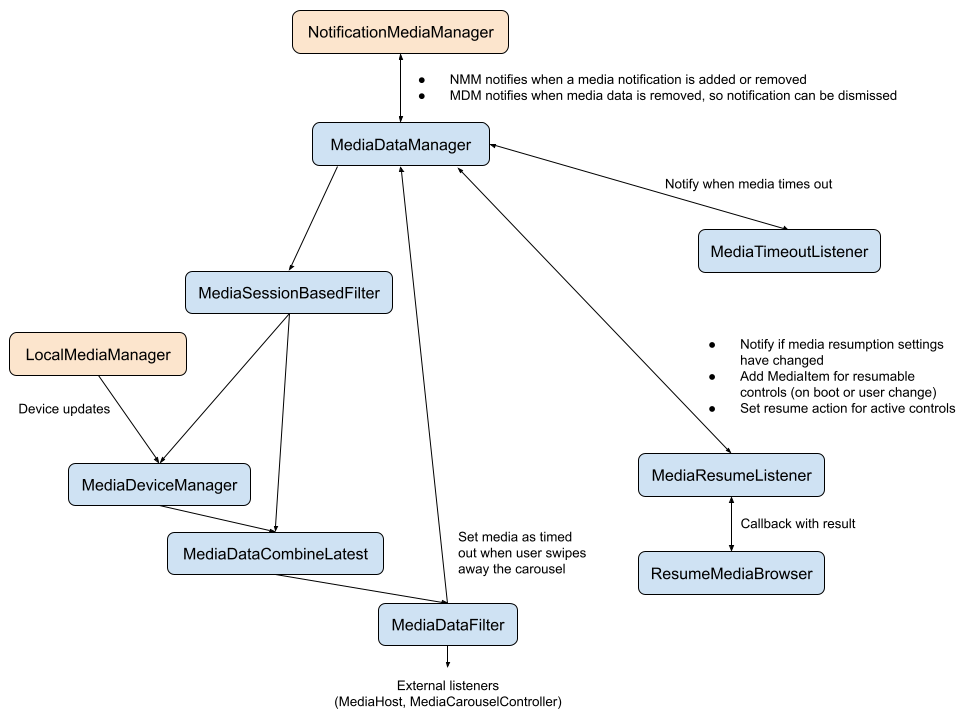# SysUI Media Controls Pipeline [TOC] ## Purpose Describe how events flow through the media controls pipeline, and provide a high level overview of what the different components do. ## Pipeline Diagram  * Orange: External inputs * Blue: Internal listeners; all except `MediaDataManager` and `ResumeMediaBrowser` implement [`MediaDataManager.Listener`](/packages/SystemUI/src/com/android/systemui/media/MediaDataManager.kt#711) and receive `onMediaDataLoaded` and `onMediaDataRemoved` events ## Classes Files under [`systemui/media/`](/packages/SystemUI/src/com/android/systemui/media/): * UI * `dialog/` * Output switcher dialog (maintained by Settings team) * IlluminationDrawable.kt * LightSourceDrawable.kt * These create the glow animation when you tap on a button (see [`qs_media_light_source`](/packages/SystemUI/res/drawable/qs_media_light_source.xml)). Should be reusable in other layouts. * Carousel: * MediaCarouselController.kt * Keeps the carousel view up to date and handles state changes (e.g. expansion) * Handles settings gear and page indicator * MediaCarouselScrollHandler.kt * Handles scrolling between players in the carousel * MediaScrollView.kt * Scrollview used in the carousel layout, has some custom measurement code * Individual players: * KeyguardMediaController.kt * Lockscreen media controls have a special wrapper in order to work with the existing lockscreen notification layout * MediaControlPanel.java * Main class for media control UI * SeekBarObserver.kt * Updates seekbar state * SeekBarViewModel.kt * Implements its own `computePosition()` for the seekbar (to avoid continually polling the `PlaybackState`, which involves binder calls) * Does some touch falsing (ignore flings, require drags to start near the thumb - otherwise users would often accidentally trigger the seekbar when they meant to move the carousel or shade) * MediaViewHolder.kt * Holds references to the UI elements in the panel * Animation support: * MediaHierarchyManager.kt * Responsible for placement of media view and animation between hosts * MediaHost.kt * Every location that a media player could be located needs a `MediaHost` * Tracks configuration (if it should show inactive media, needs falsing, etc.) * MediaHostStatesManager.kt * Manages the various media host states and coordinates heights between different players * Has the most up to date state for any location * MediaViewController.kt * Controls a single instance of a media player, keeps the media view states up to date * Backend * MediaData.kt * Holds all the media data (track info, active/resume state, etc.) * MediaDataCombineLatest.kt * Combines update events from `MediaDataManager` and `MediaDeviceManager`, so that downstream listeners will have device info * MediaDataFilter.kt * Filters media data based on the current user * Exit point for the pipeline: "external listeners" (currently `MediaHost` and `MediaCarouselController`), while they should be added via `MediaDataManager.addListener()`, will actually be listening to this output * MediaDataManager.kt * Entry point for the pipeline; initializes listener connections and assigns external listeners to the correct exit point * Converts media notifications and resumable media info into `MediaData` * MediaDeviceManager.kt * Handles device updates * MediaFeatureFlag.kt * Utility to check whether media controls are enabled * MediaSessionBasedFilter.kt * Filters media events based on media session. This prevents duplicate controls in situations like casting where we might get both a local and remote object for the same media session. * MediaTimeoutListener.kt * Listens to `PlaybackState` and marks controls inactive after the media has been paused/stopped for 10 minutes (value can be adjusted locally with `adb shell setprop debug.sysui.media_timeout [ms]`) * MediaResumeListener.kt * Listens for new media data and attempts to find a valid `MediaBrowserService` for the app. If successful, sends the information back to the `MediaDataManager` * Saves up to 5 valid `MediaBrowserService` components found this way, and queries them for recent media on boot or user change * Note: the user can disable this feature completely (or block certain apps from being resumable) in [Settings](https://source.corp.google.com/android/packages/apps/Settings/src/com/android/settings/sound/ResumableMediaAppsController.java), in which case this listener will do nothing (or ignore updates from the blocked apps). * ResumeMediaBrowser.java * Connects to an app's [`MediaBrowser`](https://developer.android.com/reference/android/media/browse/MediaBrowser) to determine whether SystemUI is able to connect and find a recent [`MediaItem`](https://developer.android.com/reference/android/media/browse/MediaBrowser.MediaItem) * Factory classes (for unit testing): * LocalMediaManagerFactory.kt * MediaBrowserFactory.java * MediaControllerFactory.java * ResumeMediaBrowserFactory.java ## Miscellaneous Other useful documents: * [go/sysui-media-resumption-requirements](https://goto.google.com/sysui-media-resumption-requirements) - Internal documentation for app developers about how to work with media resumption * [Playing nicely with media controls](https://android-developers.googleblog.com/2020/08/playing-nicely-with-media-controls.html) - blog post on the Android 11 updates * [Media Controls developer guide](https://developer.android.com/guide/topics/media/media-controls)